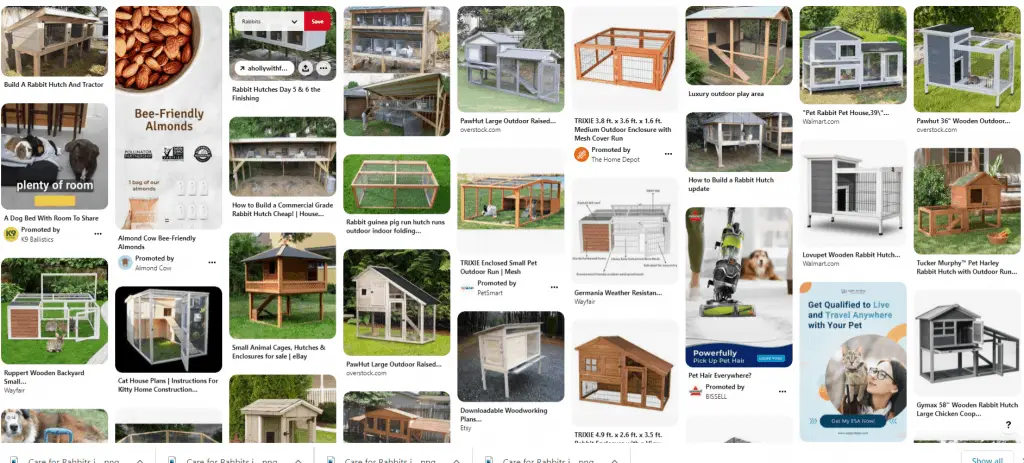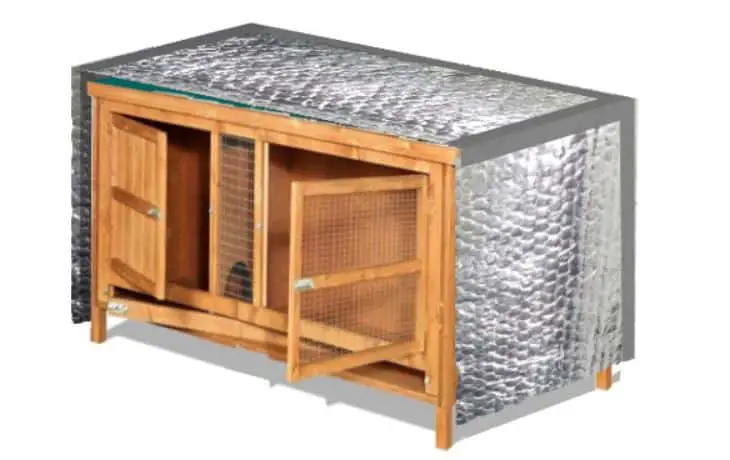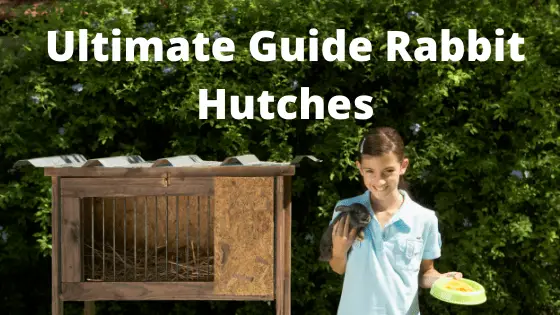Rabbit Farming Cage Design – As a general rule rabbit hutches vary according to location, climate, and personal preference. 1) Young Rabbits need 3/4 sq ft each 2) Adults need 2′ x x3′ 3) Doe and newborns 2′ x 3′ 4) Doe and younger kits 2′ x 4′ If in a warm climate hutch should take into consideration cooling factors. If in cold climate rain, snow, drafts, and chill factors all should be a part of the build. There are man prefabricated hutches that can be found online.
Rabbit Farming Cage Design / Size of Rabbit Hutches Needed – Rabbit Cage
In Commercial Rabbit Farming Operations – There are many factors that will play an important factor in your Rabbit Profitability When you start rabbit farming the first thing you need is space.
Space required per animal is 10 to 15 square feet per animal. Space requirement is different at different stages of rabbit life if rabbit farming is done in the cage. Rabbit Farming Cage Design
- Rabbits (5-12 weeks) 0.07 square meter (per rabbit) – .75 Sq Ft
- Rabbits (12 weeks or more) 0.18 square meter (per rabbit) – 2 sq Feet = 1′ x 2′
- The adult does and bucks for breeding 0.56 square meter (per rabbit) – 6 sq Feet = 2′ x 3′
- Doe and litter (5 weeks) 0.56 square meter (total area) – 6 Square Feet = 2′ x 3′
- Doe and litter (8 weeks) 0.74 square meter (total area) – 8 square feet = 2′ x 4′
See Amazons Resources for Looking at Available Rabbit Hutches
You can also Read our Guide –18 Ways to Make Money by Rabbit Farming—Extensive Guidelines for Rabbit Farmers
Outdoor
Raising Rabbits in Cold Climate – Farming
Rabbit Hutches – Rabbits are amazing creatures and they adapt very well to cold Temperatures. In the wild they burrow in the ground and no matter how cold it gets they are sustained by ground Temperatures from the extremes.
They also have a high metabolism so they require more food in the winter to munch on. Maintaining fresh unfrozen water is also a challenge when building your Hutches. Wind, Extreme Temperatures can Kill some of Your Herd so you will need to take extra measures during Extreme Cold Weather
- Rabbits can thrive in Cold Temperatures
- They Need to eat More to generate heat
- Drafts and Winds can Be deadly to a Rabbit
- 40 – 45 Degrees is great average temperature – Guage temperature in the ground of the surrounding dirt – in Nature their dens lined with Fur and leaves – Which are all insulators
- When Freezing Rabbits Toes and Ears will be affected First
- Dampness in Hutches through water or Urine can complicate the Cold
- Challenging Keeping them with Fresh unfrozen Water
- Catching Colds and Illnesses more prevalent in Cold Weather
- Rabbits seem to like Fleece Blanket – again keep them dry
Breeding Rabbits in Hot Climates – Housing
Raising Rabbits in Extremely Hot Climates can be challenging also. Rabbit Farms have come up with creative ways to keep your Herd cool. Rearing in the correct housing with the right equipment is important.
- Solar Fans
- White Reflective Roofing
- Frozen Ice Cubes
- Frozen Fruit
- Cooling Totes
- Marble Tile 12′ x 12″ in Each Pen will allow the Bunny so sit on it and it will be cool to the touch
- Hot Climate
- Cold Climate
- Rainy Climate
- Dry Climate
Raising Rabbits in Rainy Climate
- Danger from rain is if Rabbits get too cold at the same time – they can easily die
- Their fur is waterproof and insulating – which tend to keep them Dry
- Rabbits in nature are comfortable sitting in Rain
- Important to keep inside hutches dry’
- Avoid letting Rabbits get completely Soak – Can Lead to pneumonia
Breeding Rabbits in Dry Climates
- Have Shade whenever possible Natural Best – Awnings if other not available
- Fan Cooling Ele / Solar / Swamp Coolers
- Mist Fans – Fans that generate fine water Mist in their Spay – which is effective in Lowering Temperatures
- Building In-Ground Rabbit Hutches / Various interesting – using Ground Temperature for cooling
- Cooling Totes – Example Rabbitry Center – works well in Both Winter for warming, Summer for Cooling
- Choose Breed Known to handle Heat
- Wire Cages Keep Rabbits Cooler allowing more Air Circulation
- 90 Degrees Rabbits go into Shock 85 Degrees Immune System Drops
- Air Conditioners
Rabbits Living Inside Your House
Many Rabbit Owners, for Pets Rabbits mostly. Choose to Keep their Pets inside their homes. It is a place where their Bunnies are Safe and Warm. Owners also try to Bunny Proof their Homes to keep Bunny and Home safe. Important Points to Remember and some Types Include
- Multi-Level Hutches / Rabbit Homes
- Mobile Hutches
- Playpens
- Rabbits should never just be kept in Cage Only – They Need Exercise to remain Healthy. Rabbits are designed to Run and Jump. If You are Keeping Your Bunny Indoors Plan for times of Exercise.
- Bunny Proof your house – They love to chew – Electric Cords, treasured Good Wooden Furniture
- Rabbits can be litter Trained
- Access to daylight for Vitamin D absorption.

Raising Rabbits Inside Barns
As a kid we had our small rabbit farm in Our Barn. It worked well. They shared the Barn with my sister’s horse, and a cow we had shortly called T – Bone – which is where he eventually ended up. Inside the barn had a lot of Advantages
- Water never froze – We lived in Ohio – Temp dropped but the inside of barn alot warmer, straw/manure kept it above freezing all the time
- We collected the droppings out from under pens and moved it to worm beds
- kept them Dry
- We never seemed to have any sickness
- Protected them from Predators
- Was hot in Summer/lack of Air Flow in Barn
- Rabbits had limited exercise
DIY – There Are a Multitude of Plans
Many Rabbit Farms start out very small and then increase in size naturally. Rabbits are prolific Breedes so you Bunny Herd can be grown Quickly. Wood is very cheap in price so it is an afternoon Project to build a rabbit, Hutch.
Wooden Rabbit Hutch
- 2 ‘ x 4 ” Pine is easy to build with – Untreated remember bunnies will chew wood – for Hutch Framing
- 4″ x 4 ” Needed for supporting your Rabbit Hutch
- Plywood for Roof – Seems to take more weather than Particle Board
- Rabbit Mesh for sides and Doors 1″ x 2″ – 14 – 16 Guage
- Rabbit Mesh Smooth 1/2″ x 1″
- Do not use chicken wire Bunnies will chew through it.
- Shingles for Roof
- Fiberglass sheathing also for the roof if applicable
- Hinges for the doors
- Slide Bolt to latch the Doors
- Tools – Saw – Coated Outdoor Nails – Staplegun – Wire cutters – Battery Drill – Level – Square
DIY Metal Rabbit Hutches/ Don’t Lose babbies!
Please note there is an important point mentioned in this video – all sites and even pre-made cages have 1″ x 2″ sides – If you are Breeding. Young Kits can wiggle out the sides and die. We also bred Bichon Dogs – this same thing does happen. So why lose babies. Make a 6″ wrap on the sides of your cages of smaller mesh .5″ x 1″ to avoid this … you will enjoy this video
DIY Stackable Rabbit Cages
Some of the important Characteristics for Stackable rabbit Hutches / Cages are following
- Have to allow for Dropping Control – so that Urine and droppings do hit those on Lower Levels
- many Made from Galvanized Metal Materials – Powder Coating is great to protect the Metal
- Each Level is usually Independent
Building Rabbit Hutch under $ 50
Rabbit Cages Made of Coated Wire Shelving
Commercial Rabbit Hutches / Cages
In Commercial Rabbit Farming Operations – There are many factors that will play an important factor in your Rabbit Profitability When you start rabbit farming the first thing you need is space.
Space required per animal is 10 to 15 square feet per animal. Space requirement is different at different stages of rabbit life if rabbit farming is done in the cage. Suggestions From PennState Ag
- If Included inside Building
- Proper Ventilation, Lighting, Heating and Cooling Systems
- For Optimal Breeding 12 Hours Light/ 12 Hours of Dark
- Metal Caging the Most Sanitary
- Mature Bucks 30″ x 30″ x 20″
- Mesh 1″ x 2″ for sides and doors, .5″ x 1″ for Floors
- Cleanliness
- Protection from Sun and Rain
- Regular Cage Disinfection
North West Rabbit Farm
North West Commercial Rabbit Farming
Predator Protection / protecting your Rabbit Farm
When Considering Rabbit Hutches and Rabbit Runs. It is very important to understand the Type of Predators that you will need to be protecting your Herd from. He is a list ..I have probably forgotten some, but this will get you started
- Foxes
- Wolves
- Dogs
- Cats
- Eagles
- Hawks
- Owls
- Falcons
- Weasels
- Snakes
- Badgers
- Raccoons
Diy Selection of Rabbit Hutch Plans
For the DIY person, there are many sets of Plans you can Buy and Build to begin your Rabbit Farm. Building Materials are readily Available at ant Home Depot, Lowes, Menards, or Tractor Supply Store.
This link will take you to 50 examples Free of DIY Rabbit Hutches that you can build. It has pictures of each Rabbit Hutch that you can create.
Rabbit Hutch Accessories
Feeders
- Individual
- Hopper
Waterers
- Automatic Waterers
- Crocks
- Enamel Cups
- Ceramic
- Cans
- Bamboo Troughs
Covers
There are Websites that will make you a custom cover for your hutch if you provide the Dimensions. Since many Hutches are custom made there is not a lot of standardization for standard covers.
Initiative and ingenuity are important. A Simple Hutch Cover can be made with – a Roll of Aluminum Covered Bubble Wrap – Duct Tape / Hog Rings / some have used zip ties ( rabbits do not seem to chew on them) for Less than $50

Bedding for Rabbit Hutches
- Newspaper
- Wood Chips Shavings
- Wood Pellets
- paper Pulp
- Straw Hay
- Fleece Bedding
- Pines Shavings
Rabbit Hutch Dropping Pans
Depending on your setup and amount of Rabbits you have will depend on if any and the type of Rabbit dropping pans. These are very advantageous in helping keep your farm sanitary.
Pans can be emptied and then droppings can be moved to Compost Beds, Worm Beds, Garden, or Bagging for resale.
I was not able to find any automated Rabbit removal systems. But there are several automated systems for chicken manure that probably could also be applied.
You would really need to evaluate Profitability. But it might give you some creative ideas for designing your own.
- Metal
- Plastic
- Wood – it is very hard using wood even though it is cheap and strong
Cleaning Rabbit Hutches
- Best done on a routine
- Weekly Schedule works Great
- Remove any unused food / Straw, Hay
- Clean any Urine / Rabbit Droopings
- Depending on cage type – wash with hot Vinegar water
- Disinfect cage with Bleach Solution 1 Pt Bleach / 10 pts Water
- Allow soaking for 30 minutes
- Allow complete Drying for Chlorine smell to dissipate
- If you have Totally Metal Cages you can also burn them to sterilize them
Rabbit Hutch for Breeding
For Single Does and Breeding Bucks a Standard 30″ x 30″ x 20″H, is fine fro your Bucks. Does and Young need larger areas. When Breeding you always take the does to the Bucks. To decrease stress and have more success in Breeding.
- This Avoids – Biting
- Drop Offs
- Buck spend a lot of time peeing to mark new territory
DIY Stackable Rabbit Cages / Advantages
Stackable Rabbit cages Present greater economies of Scale. Most smaller Farms have single Hutches, many hanging for sanitation Points to remember
- Allows you to double the number of Rabbits in Building size
- Have to maintain good cleaning schedules to avoid sanitation problems and disease
- protect lower levels from manure and urine coming from above
- Cleanable easy to remove an access Rabbit Droopin Pans
- If Moble or built-in Units are easier to take to cleaning area to sterilize when needed
- Temperature control cost is now spread across twice as many stocks
- make sure you have good access to your rabbits as you develope your Stackable systems
Rabbit Hutch Heating Methods
- Heating Pad inside Hutch – Protect from Rabbit Chewing on Cord
- Heat Lamp/Light / Some breeders suggested putting bulb in Tin Can to protect the rabbit from Bulb
- Insulate Outside of hutches against Freezing Weather
- Provide Extra Bedding Hay / Straw in colder Weather
- Protect from Drafts
Rabbit Hutch on Wheels
This Google Image Search will Give you Some Creative Ideas
Rabbit Hutch Size / Michigan State University
This Link from Michigan University will help you in Determining Cage Size
- Sizing Chart has also been adopted by the American Rabbit Breeders Association
- Cage size per Rabbit Weight – Determine your Breeds average size to use
- Cage Size for Nursing Rabbits
- This table has been adapted to the Animal Welfare Act.
Rabbit Hutch Urine Guards / Rabbits don’t Pee Straight
- Urine Guards Can be purchased or Fabricated
- Keeps Urine from Being Sprayed outside Pan area
- Bunnies tend to use one corner of Cage for waste.
- Will direct Urine to Collection Pan
- Rabbits usually do not pee straight down
- Usually, Pee opposite side where their feen is
- Urine guard can also help keep from losing Kts ( Baby Rabbits )through the sides of the Pens
Rabbit Hutches with Exercise Runs
- Suggested Minimum size is 8′ x 4′ Needs Height enough Rabbit can stand up
- Needs Roof to protect from Predators
- If you make it Moveable you can change grazing areas
- Suggest easy Acess to be able to retrieve your Rabbits
- Make them weatherproof – for durability
- Images from Google on Rabbit Runs for your Ideas
What We Wish We Knew
Types of Rabbit Housing
Wire cages – Wire cages are one of the most popular types of rabbit housing. They’re typically made from welded wire and have a removable bottom pan for easy cleaning. One advantage of wire cages is that they offer good ventilation. However, they can also be expensive, and rabbits can sometimes damage their feet on the wire mesh.
Wooden hutches – Wooden hutches are another popular type of rabbit housing. They can be made from a variety of materials, but most are made from either plywood or solid wood. One advantage of wooden hutches is that they provide rabbits with a sense of security. However, they can be difficult to clean and don’t offer as much ventilation as wire cages.
Dog crates – Dog crates can also be used for housing rabbits. They’re typically made from either plastic or metal and have a removable bottom tray for easy cleaning. One advantage of dog crates is that they’re relatively inexpensive. However, they’re not as spacious as wire cages or wooden hutches, and they don’t offer as much ventilation.
Homemade rabbit cages – Homemade rabbit cages are another option for housing rabbits. They can be made from a variety of materials, including wire mesh, wood, and even PVC pipe. One advantage of homemade rabbit cages is that they’re often more affordable than commercially-available cages. However, they can be more difficult to clean and may not offer as much ventilation as commercially-available cages.





